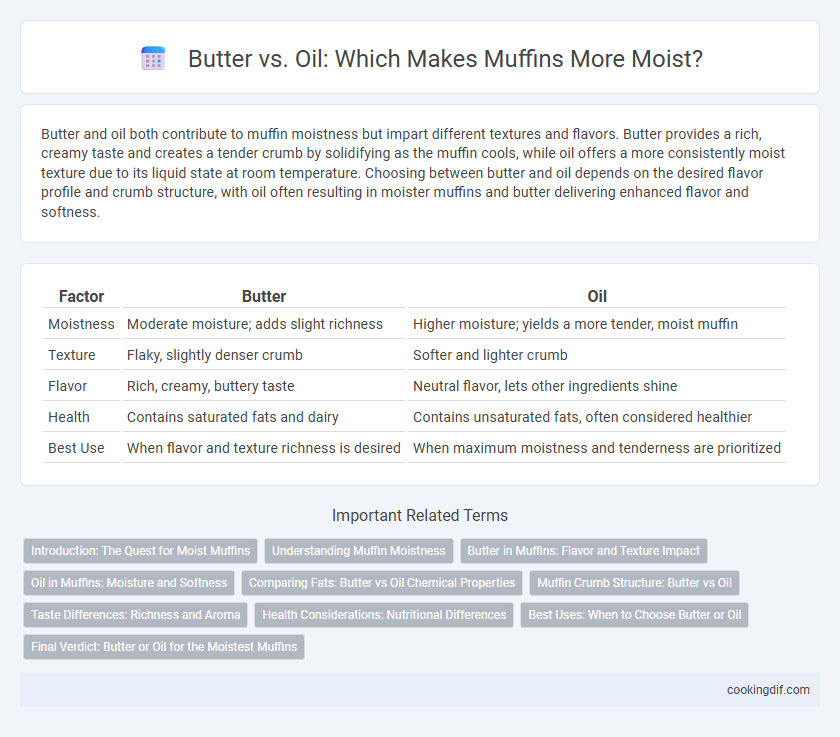Butter and oil both contribute to muffin moistness but impart different textures and flavors. Butter provides a rich, creamy taste and creates a tender crumb by solidifying as the muffin cools, while oil offers a more consistently moist texture due to its liquid state at room temperature. Choosing between butter and oil depends on the desired flavor profile and crumb structure, with oil often resulting in moister muffins and butter delivering enhanced flavor and softness.
Table of Comparison
| Factor | Butter | Oil |
|---|---|---|
| Moistness | Moderate moisture; adds slight richness | Higher moisture; yields a more tender, moist muffin |
| Texture | Flaky, slightly denser crumb | Softer and lighter crumb |
| Flavor | Rich, creamy, buttery taste | Neutral flavor, lets other ingredients shine |
| Health | Contains saturated fats and dairy | Contains unsaturated fats, often considered healthier |
| Best Use | When flavor and texture richness is desired | When maximum moistness and tenderness are prioritized |
Introduction: The Quest for Moist Muffins
Butter enhances muffin flavor with rich, creamy notes while providing a tender crumb, but can sometimes yield a denser texture. Oil contributes to greater moisture retention and a lighter, softer crumb due to its liquid state at room temperature. Choosing between butter and oil depends on the desired balance of moistness, texture, and flavor in muffin baking.
Understanding Muffin Moistness
Butter enhances muffin moistness by adding rich flavor and a tender crumb due to its fat content and water, which creates steam during baking. Oil contributes to a denser, moister texture because it remains liquid at room temperature, preventing the muffin from drying out. Selecting between butter and oil depends on the desired muffin texture and flavor profile, with oil providing superior moistness and butter delivering more complex taste.
Butter in Muffins: Flavor and Texture Impact
Butter in muffins contributes a rich, creamy flavor and creates a tender crumb due to its solid fat content, which traps air during creaming, enhancing texture. The water content in butter also helps steam and leavens muffins, resulting in a moist interior without greasiness. Unlike oil, butter imparts a fuller taste and slightly denser, more structured crumb, preferred in classic muffin recipes.
Oil in Muffins: Moisture and Softness
Oil contributes to muffin moisture and softness by coating flour proteins, which inhibits gluten formation and results in a tender crumb. Unlike butter, oil remains liquid at room temperature, helping muffins retain moisture longer and stay fresher. Using oil enhances the overall texture, producing moist, soft muffins with a delicate crumb structure.
Comparing Fats: Butter vs Oil Chemical Properties
Butter contains about 80% fat and 16-18% water, which contributes to a denser muffin texture, while oil is 100% fat, resulting in a moister and lighter crumb. The saturated fats in butter provide structure and richness, whereas the unsaturated fats in oil create tenderness by coating flour proteins and inhibiting gluten formation. Chemically, the water in butter causes steam during baking, affecting rise and crumb, while oil's consistent fat content enhances moisture retention.
Muffin Crumb Structure: Butter vs Oil
Butter creates a tender muffin crumb with a rich flavor due to its solid fat content, which traps air during creaming, resulting in a finer, more structured crumb. Oil, being liquid at room temperature, produces a denser and moister muffin crumb without the flakiness, offering a softer texture that retains moisture longer. The choice between butter and oil directly influences the muffin's crumb density, moisture retention, and overall texture, making butter ideal for airy muffins and oil preferable for moist, tender bites.
Taste Differences: Richness and Aroma
Butter imparts a rich, creamy flavor and a distinctive aromatic quality that enhances the overall taste of muffins, creating a more indulgent eating experience. Oil contributes to moistness without altering the flavor significantly, resulting in a lighter texture but a less pronounced richness compared to butter. The choice between butter and oil ultimately influences the muffin's depth of flavor and aromatic appeal, with butter offering a fuller, more robust taste profile.
Health Considerations: Nutritional Differences
Butter contains saturated fats and cholesterol, which can impact heart health if consumed in excess, while oil, especially vegetable or olive oil, offers healthier unsaturated fats that support cardiovascular wellness. Oil provides essential fatty acids and vitamin E, promoting better skin and immune function compared to butter's limited nutrient profile. Choosing oil over butter for muffin recipes can reduce saturated fat intake and enhance nutritional value, contributing to overall health-conscious baking.
Best Uses: When to Choose Butter or Oil
Butter provides rich flavor and a tender crumb, making it ideal for muffins where a buttery taste is desired, such as blueberry or banana varieties. Oil yields a moister texture and longer shelf life, perfect for denser muffins like zucchini or carrot that benefit from added moisture. Choose butter for flavor depth and structure, while oil suits recipes prioritizing soft, moist results.
Final Verdict: Butter or Oil for the Moistest Muffins
Oil-based muffins generally retain more moisture due to oil's liquid state at room temperature, which prevents dryness and maintains a tender crumb. Butter contributes rich flavor and a slightly denser texture but can yield a drier muffin if overbaked or cooled. For the moistest muffins, oil is the preferred fat, ensuring consistent softness and prolonged freshness without compromising taste.
Butter vs Oil for muffin moistness Infographic

 cookingdif.com
cookingdif.com